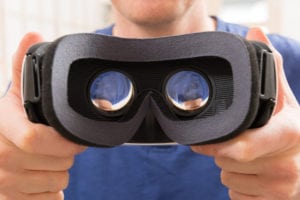A New Frontier For Storytelling
I stand on the edge of a cliff, awaiting inevitable free fall.
I walk on the Moon.
I dance among performers on stage at the Cirque Du Soleil.
I pilot a World War 2 fighter jet.
I sit, bound to my wheelchair, as I’m pushed through an insane asylum.
With modern virtual reality technology, you can experience all these things, and much more.
If you’ve never immersed yourself in virtual reality before, it’s a sensation like no other. It’s an immersive, computer-simulated experience that is interactive in a seemingly real, physical way—creating a sensory feeling of existing in an environment other than your own.
And while it is still an evolving medium, its current presence is bigger than most realize. In the past year, virtual reality has taken the nation by storm; over 30 VR experiences appeared at the 2016 Sundance Film Festival, a reported 4.8 million paying customers used products this year and the Oculus Rift, an advanced VR consumer headset, sold out in minutes on its March 28, 2016, release.
And the possibilities for virtual reality continue to extend to new industries. In May, the VR company NextVR announced its partnership with the event promoter Live Nation. Together, they will bring hundreds of live performances to the world of virtual reality—allowing people to take a front-row seat at the biggest concert of the year without physically being there.
In the automotive industry, Audi recently announced a new showroom technique that allows customers to explore their own personalized “dream car” using an HTC Vive virtual reality headset, surrounded by settings ranging from Paris to the surface of the moon.
Imagine the opportunities. In real estate, buyers could visit perspective homes without leaving their own. In education, students could experience simulated historical events. In tourism, travelers could explore worldwide destinations without the long plane rides.
But the industry that will see the biggest transformation is our own; virtual reality could begin a new era for news media.
Currently, people can receive news instantaneously. But in the future, VR could allow people to live within it—experiencing, rather than seeing, media content.
With VR, you can experience life through the eyes of a young girl living in the Zaatari Refugee Camp, an Ebola survivor in a Liberian village, or a starving homeless man at a food bank in Los Angeles. Virtual reality can take you places you will never go, and expose you to lives you will never have—leading to a reinvigoration of human emotion and compassion.
Chris Milk, the founder and CEO of VR production company Within, calls virtual reality an “empathy machine”. In his April 2015 Ted Talk he said, “It connects humans to other humans in a profound way that I’ve never seen before in any other form of media… through this machine we become more compassionate, we become more empathetic, and we become more connected. And ultimately, we become more human.”
With this, there is an opportunity for the media industry to redefine digitalized human interactions.
Mark Zuckerberg wrote a Facebook post in March 2014 announcing his company’s $2 billion acquisition of Oculus, a leading VR technology company. He said, “By feeling truly present, you can share unbounded spaces and experiences with the people in your life. Imagine sharing not just moments with your friends online, but entire experiences and adventures.” It seems Facebook’s shift to VR could present a new definition of social networks; a virtualized world where humans exist and interact within each other’s experiences.
As social media platforms continue to adopt virtual reality, the news industry will follow. In news, a fully-immersive, live story could allow humans to authentically experience content, rather than consume it through interpretation. Journalist Nonny de la Peña, creator of the VR production Project Syria, said in a recent interview: “Journalists will realize really fast that VR has a unique power to place viewers on the scene of an event—instead of watching it from outside—and that that’s a really powerful way to engage them emotionally.”
This new frontier for journalism has already arrived. The New York Timeshas produced six VR films and distributed Google Cardboard virtual reality headsets to subscribers. And in 2014, the Des Moines Register and Gannett Digital released Harvest of Change, a virtual reality story that gives new perspective to cultural and economic issues in rural America.
From here, the possibilities are seemingly limitless; our modern progressions are just a starting point in VR’s rise. According to a January 2016 analysis from Digi-Capital, the industry is predicted to hit $30 billion in revenue by 2020. And in a recent Thrillist article, Jody Medich suggested the possibility of contact lens with VR capabilities in as soon as 10 years.
We could be on the brink of an extraordinary revolution—much like the early stages of the computer, the internet or the smart phone.
But it must be understood that virtual reality is fundamentally different from any platform before it. It’s not just a provider of games, film or entertainment; it’s a generator of raw human empathy. It’s a manifestation that could be followed by evolutions in nearly every industry. It’s a technology that uses human consciousness as a medium.
It’s our future.

